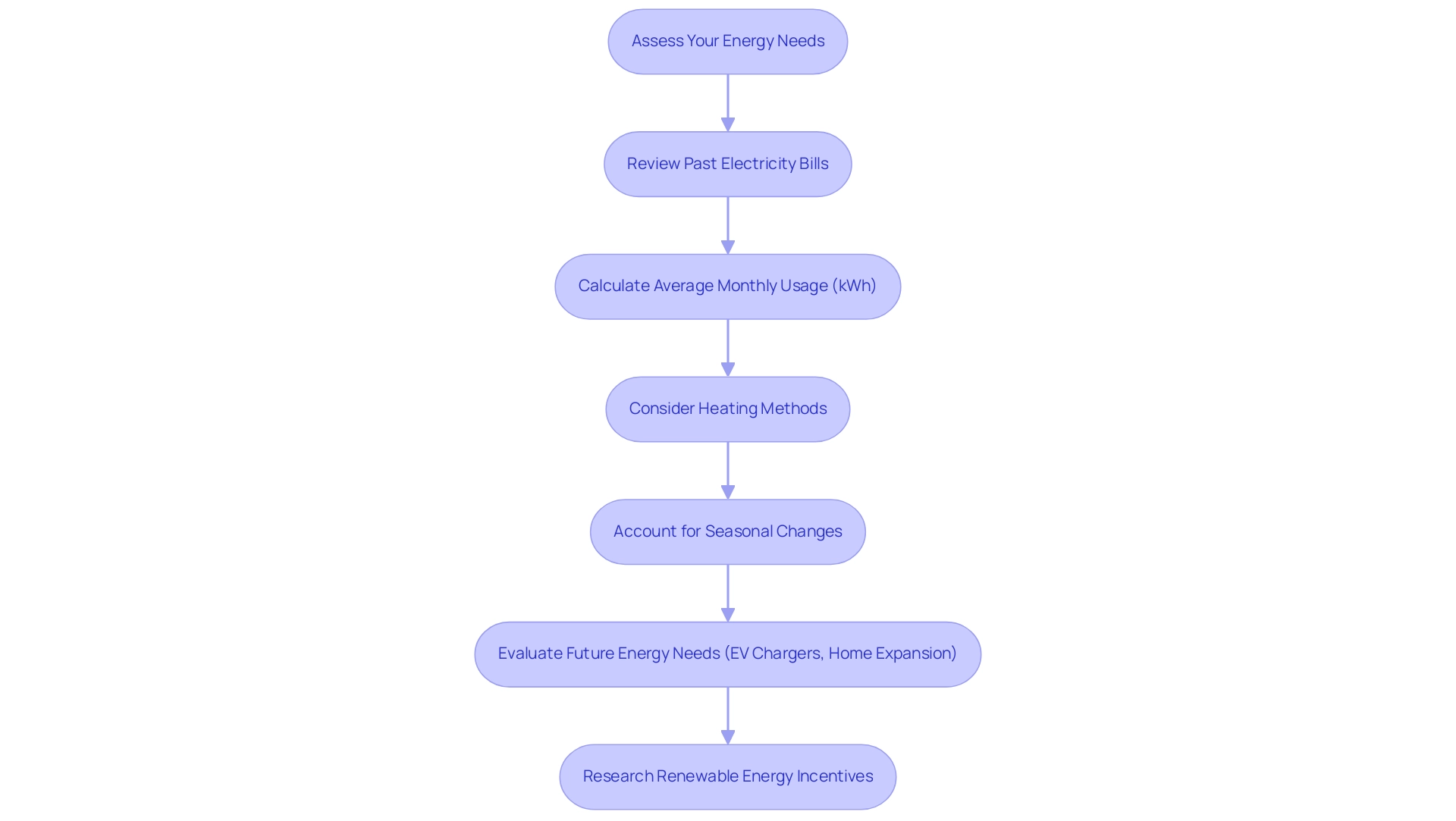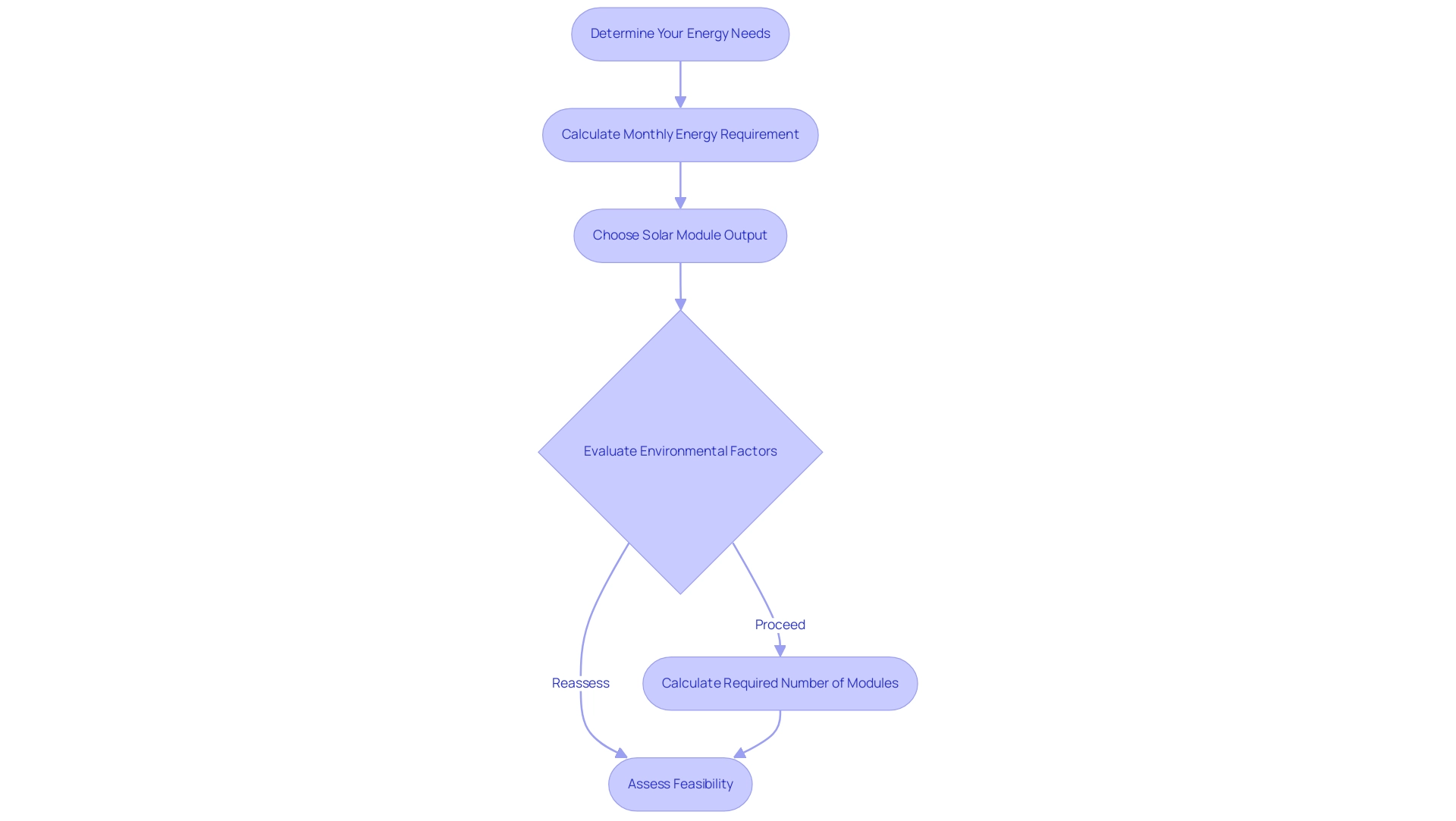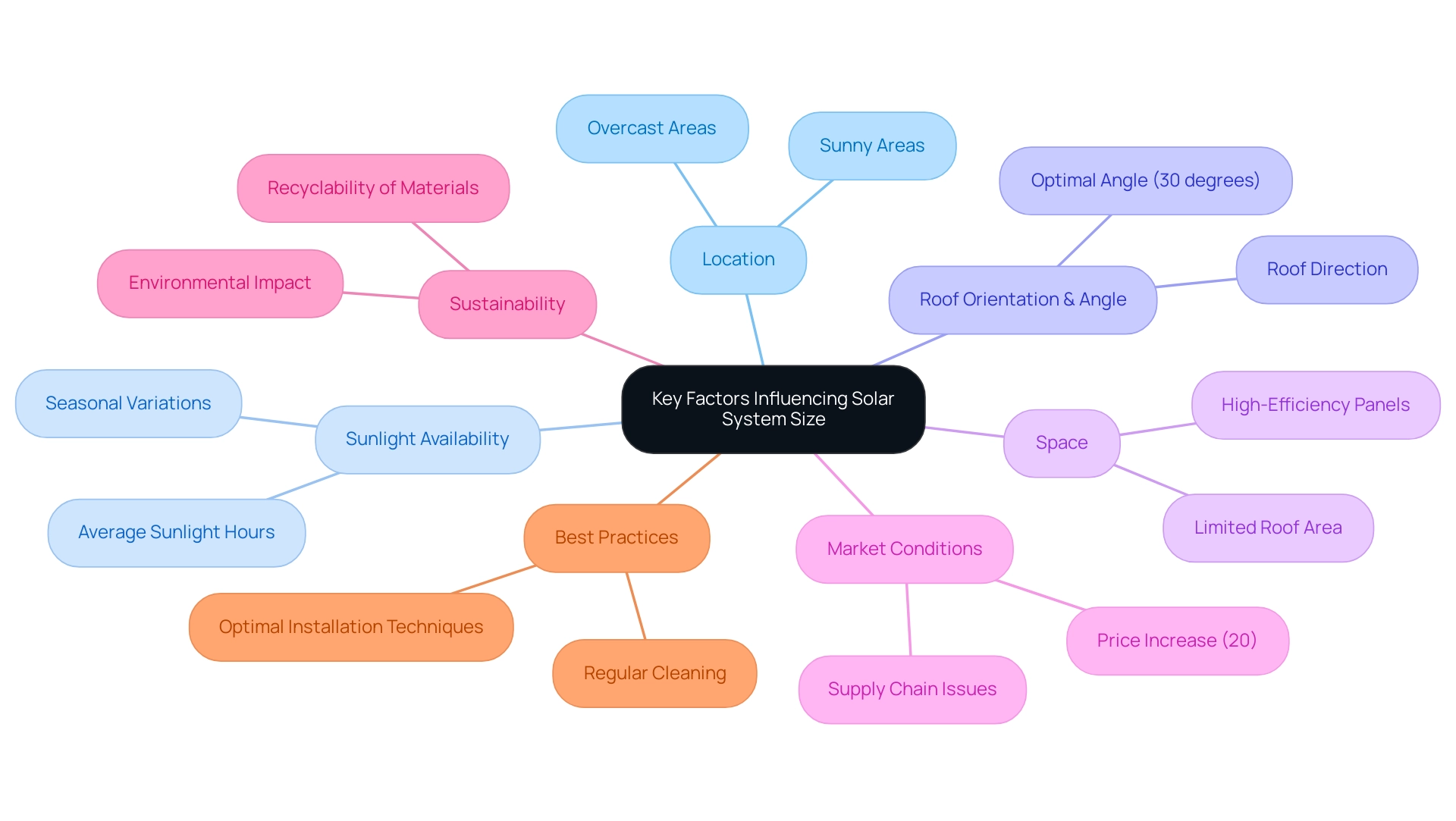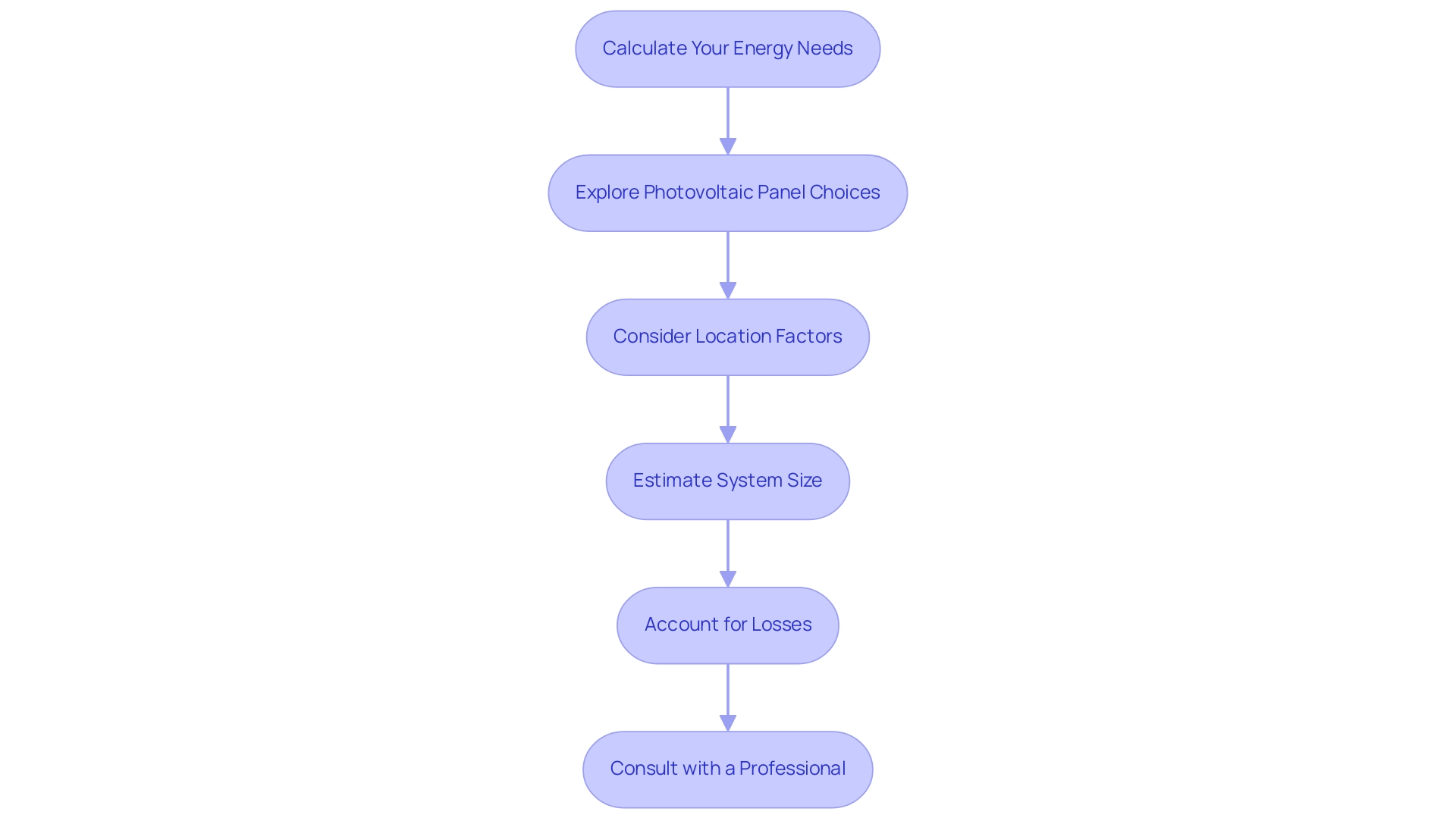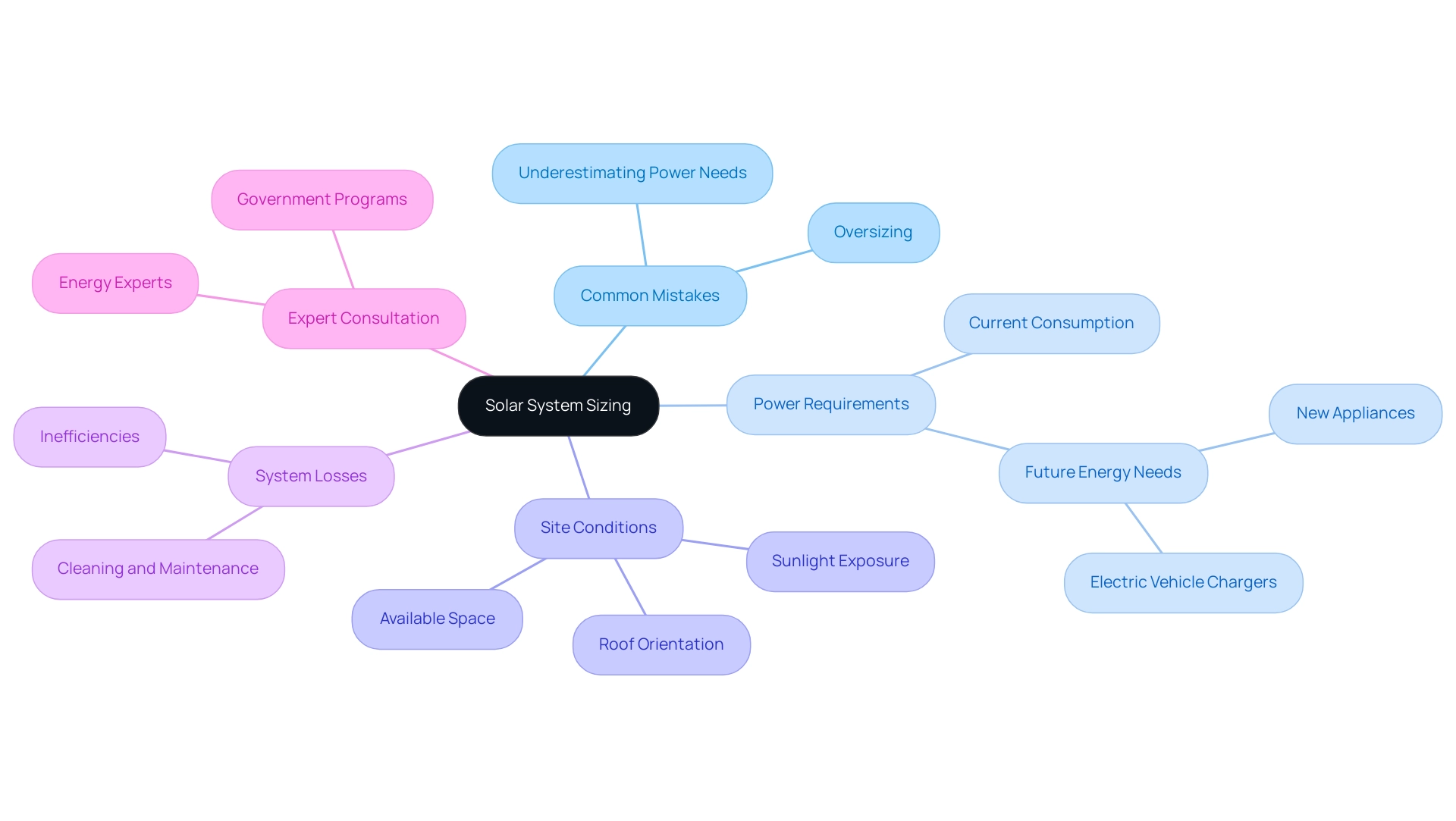Overview
To determine the appropriate size of a solar system, homeowners must first assess their energy needs by reviewing past electricity bills and calculating average monthly usage in kilowatt-hours (kWh). The article emphasizes that factors such as geographical location, roof orientation, and efficiency ratings of solar panels play critical roles in calculating the necessary solar capacity to meet power requirements effectively.
Introduction
Navigating the transition to solar energy can feel overwhelming, especially with the myriad of options and considerations involved in sizing a solar system. Homeowners seeking to harness the sun’s power must first understand their unique energy needs, which can vary significantly based on household habits and regional factors.
From analyzing electricity bills to accounting for seasonal changes, the journey begins with a thorough assessment of usage patterns. As the solar landscape evolves, recognizing the interplay of panel efficiency, location, and available sunlight becomes crucial.
With practical steps and expert insights, homeowners can confidently size their solar systems, ensuring they not only meet their energy demands but also contribute to a sustainable future. This guide will illuminate the path to making informed decisions, helping to transform solar aspirations into reality.
Assessing Your Energy Needs: The First Step in Solar Sizing
Before you jump into the world of solar panel specifications, it’s essential to consider what size solar do I need by evaluating your power requirements. A good starting point to figure out what size solar do I need is to dig out your electricity bills from the past year and calculate your average monthly usage in kilowatt-hours (kWh). In Wyoming, for example, with 278,599 customers, the average monthly consumption is about 867 kWh, but your usage may differ depending on your household habits and the kind of heating method you utilize.
Residences with electric heating methods usually use more electricity than those depending on natural gas or heating oil, which is a significant factor when determining what size solar do I need for your power needs evaluation. Don’t forget to consider seasonal changes, as heating and cooling can dramatically influence your power usage. As Hannah Bastawrose (Seeger) wisely points out,
So, if you want to reduce your consumption, consider efficient AC systems (or adjusting your thermostat), and efficient space and water heating systems.
Furthermore, trends in power usage across the U.S. suggest that areas with distinct climates face differing power requirements, which could help determine what size solar do I need for panel sizing. If you’re also considering integrating a Tesla home charger for an electric vehicle or planning to expand your home, these changes could significantly affect what size solar do I need. Comprehending how photovoltaic systems function, including their capacity to transform sunlight into power and the advantages of net metering, is vital for ensuring you produce sufficient electricity to satisfy your needs without incurring excessive costs on unneeded capacity.
Furthermore, investigating government initiatives that offer incentives for renewable energy system installation can assist in reducing upfront expenses. When choosing photovoltaic inverters and battery alternatives, take into account efficiency ratings and compatibility with your system to optimize power storage and utilization. So take the time to evaluate your needs—it’s the first step towards a sustainable power future!
Understanding Solar Panel Output and Efficiency for Accurate Sizing
Understanding solar module output is essential for homeowners looking to harness solar energy effectively and enjoy its many benefits. Measured in watts, this output indicates the amount of electricity a device can produce under ideal conditions. However, real-world factors such as temperature, shading, and orientation of the modules can significantly influence actual performance.
For instance, during overcast weather, solar collectors may produce only 10 to 25% of their typical output, reflecting a significant difference of around 0.73 GW compared to brighter conditions. Efficiency ratings, which typically range from 15% to 22%, provide insight into how effectively a system converts sunlight into electricity. Not only does this affect your utility expenses, but it also improves your independence, allowing you to depend less on the grid and contribute to a more sustainable future.
Companies such as Canadian Solar and LONGi are actively lowering the expenses of high-efficiency modules while preserving quality, making renewable power more attainable for homeowners. To determine what size solar do I need for your power system, start by dividing your overall power requirements by the output of the modules you select. For instance, if your home requires 800 kWh per month and you choose modules that generate 300 watts each, you would need to assess what size solar do I need, which would be approximately 24 units to fulfill your power needs under ideal conditions.
Additionally, for individuals lacking roof space for photovoltaic systems, community renewable programs offer an option, enabling involvement in sustainable initiatives. Catherine Lane, a seasoned expert in the renewable energy sector, emphasizes that understanding these metrics and considering the advantages of battery backups for reliable power during outages are crucial for accurate sizing, ensuring that your setup can deliver optimal energy production and efficiency. To discover how photovoltaic panels can benefit you, obtain your complimentary, customized estimate today.
Furthermore, numerous property owners have effectively employed the 200% Rule to enhance their energy setup’s efficiency, showcasing the concrete advantages of adopting renewable energy.
Key Factors Influencing Solar System Size: Location, Sunlight, and Space
When considering what size solar do I need for your home solar system, several key factors come into play, notably your geographical location and the sunlight availability in your area. Residences situated in sunny areas can frequently manage with fewer units compared to those in overcast climates to produce the same quantity of power. The orientation and angle of your roof also play a critical role; an optimal setup will capture more sunlight, enhancing efficiency and output.
Space is another crucial factor; if your roof has limited area, it becomes necessary to consider higher-efficiency panels to meet your power requirements effectively. As Barry Elad, a senior writer in the renewable energy sector, highlights, “About 90% to 97% of photovoltaic material is recyclable and can be reused for other purposes when it breaks down.” This sustainability aspect emphasizes why investing in renewable energy systems not only meets your energy requirements but also promotes environmentally friendly practices.
Additionally, with elevated commodity costs and supply chain obstacles causing a 20% rise in photovoltaic prices over the past year, comprehending market conditions is essential for making informed choices. Comprehensive regulatory frameworks are necessary to define responsibilities for the collection and recycling of photovoltaic panels, ensuring the sustainability of your investment. In 2024, the average sunlight hours vary significantly by region, making it crucial to adjust your expectations based on where you live.
Regions with extended sunlight hours will naturally produce more power, which raises the question of what size solar do I need and the kind of installation best suited for your home. With renewable energy projected to provide more than 26% of global electricity by 2050, understanding these factors empowers you to tailor your energy system to your unique situation, ultimately making a positive impact on both your household and the environment. Investigating different energy service providers like Company A, recognized for its competitive pricing and outstanding customer support, or Company B, which provides high-efficiency modules with strong warranties, can assist you in discovering the best value in energy solutions.
Additionally, implementing best practices like ensuring your panels are installed at the optimal angle of 30 degrees and regularly cleaning them can significantly maximize panel output, ensuring you get the most out of your investment.
Step-by-Step Guide to Sizing Your Solar System
Sizing your solar system can be a straightforward yet rewarding process when you follow these steps:
- Calculate Your Energy Needs: Start by reviewing your electricity bills to find your average monthly kWh usage. This will serve as your reference for assessing how much renewable power you require.
- Explore Photovoltaic Panel Choices: Examine different photovoltaic panels with appropriate wattage and efficiency ratings that correspond with your power needs. Make sure to understand the various types of setups available—grid-tied, off-grid, and hybrid—as each has its own benefits and costs.
- Consider Location Factors: Take a close look at your roof’s orientation, any potential shading from nearby trees or buildings, and the average sunlight hours your area receives. These elements greatly affect the amount of power your photovoltaic setup can produce. Additionally, considering local solar incentives and net metering policies in 2024 can influence the optimal installation size.
- Estimate System Size: Divide your monthly power requirements by the expected output of your chosen panels to calculate the total wattage needed. This will provide you with a more distinct view of the scale required to fulfill your power requirements.
- Account for Losses: Don’t forget to consider potential energy losses, which are typically around 15% due to inefficiencies in the energy setup. As one expert noted, “Identify inefficiencies in roofing businesses, from scheduling to costs, and find tools to improve efficiency and profitability.” This adjustment will help you avoid underestimating your needs.
- Consult with a Professional: Once you have a rough estimate, it’s wise to consult with a panel installation expert. They can help refine your calculations, provide insights on the best equipment, and discuss installation options that fit your needs. For example, selecting grid-tie renewable energy equipment can be simplified through grid-tied energy packages, which provide various options after sizing a power setup. Notably, imported units are often more cost-effective, providing approximately 10% more production for the same price.
By adhering to this organized method, you’ll be well-prepared to identify what size solar do I need for your power setup, enabling you to utilize sunlight while reaping the advantages of reduced utility costs and a smaller carbon footprint. Additionally, referring to the ‘How Photovoltaic Panels Operate on a House’ user manual can offer extra insights into the functionality of photovoltaic panels, while comprehending the economic and ecological advantages of heating solutions can further improve your decision-making process. Furthermore, evaluating battery options for power storage is essential for enhancing the effectiveness of your photovoltaic setup.
Avoiding Common Mistakes in Solar System Sizing
When figuring out what size solar do I need for your setup, it’s crucial to avoid common pitfalls to maximize efficiency and minimize costs. A common oversight is underestimating your power requirements, which leads to the question of what size solar do I need to ensure your system can keep pace with your consumption. On the other hand, determining what size solar do I need and oversizing can lead to unnecessary expenses and wasted resources.
As experts emphasize, evaluating site conditions—such as sunlight exposure, roof orientation, and available space—is crucial for understanding what size solar do I need to optimize panel placement. Additionally, consider what size solar do I need for your future energy requirements, especially if you plan to add new appliances or even a Tesla home charger. If you are a renter, inquire about any government programs that facilitate access to renewable energy for your situation, which can provide financial incentives or support.
When determining what size solar do I need, remember to account for system losses due to inefficiencies. Projects like the Waterglen energy array in Fort Collins highlight the importance of proper sizing in contributing to community sustainability goals. Comprehending your electricity usage patterns is also essential, especially with utilities implementing time-of-use billing, as it can help determine what size solar do I need for effective resource management.
To determine the overall power produced by your photovoltaic setup, apply the formula:
- Total peak sun hours x Total photovoltaic size kW = Total power produced in kWh per day.
Consulting with energy experts can help you understand what size solar do I need to customize a system specifically for your household’s needs. By identifying these common errors and planning accordingly, you can make informed choices that lead to optimal savings—potentially reducing your costs by up to 85%—and fostering a greener home.
Additionally, consider regular cleaning services for your solar panels to maintain efficiency and explore various solar battery options to enhance your energy storage capabilities.
Conclusion
Understanding how to size a solar system is an empowering journey that begins with a comprehensive assessment of energy needs. By analyzing electricity bills and considering factors such as seasonal changes and household habits, homeowners can gain valuable insights into their unique consumption patterns. This foundational step not only guides the selection of appropriate solar panel specifications but also lays the groundwork for a sustainable energy future.
As the article outlines, key considerations like solar panel output, efficiency, and geographical location play critical roles in determining the ideal system size. It’s essential to recognize how local sunlight availability and roof orientation can impact solar energy generation. With the right information, homeowners can make informed choices that maximize efficiency and reduce costs, ensuring that their investment in solar energy is both practical and beneficial.
By following a step-by-step approach to sizing a solar system, including consulting with professionals and avoiding common mistakes, homeowners can confidently navigate the process. This careful planning not only leads to significant energy savings but also contributes to a greener planet. As more individuals take the leap into solar energy, the collective impact of these informed decisions can drive the shift toward a sustainable future, making solar aspirations a reality for many households.



